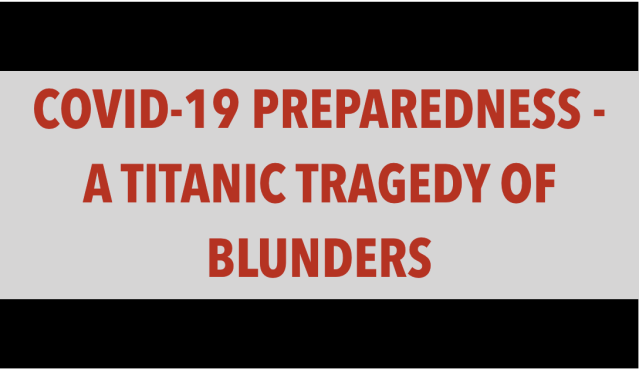Thirteen years back,
The American Society for Microbiology (ASM) had discussed the Severe Acute Respiratory Syndrome Coronavirus as an Agent of Emerging and Reemerging Infection in the year 2007.
Thirteen years back,
the paper asked the question – “Should we be ready for the reemergence of SARS?”, and further went on to say, “Coronaviruses are well known to undergo genetic recombination (375), which may lead to new genotypes and outbreaks. The presence of a large reservoir of SARS-CoV-like viruses in horseshoe bats, together with the culture of eating exotic mammals in southern China, is a time bomb. The possibility of the re-emergence of SARS and other novel viruses from animals or laboratories and therefore the need for preparedness should not be ignored.” [1]
Prophetic? No.
It was a report rooted in scientific research by one of the largest single life science societies in the world.
Thirteen years on, we are here in 2020.
The coronavirus has indeed reemerged as novel coronavirus or COVID-19 or nCov19.
COVID-19 was first detected and reported in Wuhan, the capital city of Hubei province in China in December 2019. On March 11, 2020, after more than 100,000 positive cases around the world, WHO declared nCov19 as a pandemic.
The response trajectory of government authorities went from dismissive to wait-and-watch to urgent action in a bid to contain or mitigate the spread of the virus. After more than 75 days, the world is now pushing hard to flatten the curve.
Containment methods (testing, isolation and contact surveillance) worked for Singapore, Taiwan, and South Korea as they deployed testing and contact tracing in the early days of the outbreak. Countries with a delayed response are rushing to implement mitigation strategies (social distancing and severe lockdown measures).
In the process, they are discovering that they are grievously ill-prepared to handle the exponential growth of COVID-19 positive cases.
“I have never seen so many people die together before my eyes,” said a nurse from one of the main hospitals in Bergamo, a city in northern Italy [2].
With nearly 70,000 positive cases and more than 6,800 deaths, the pandemic’s epicenter had moved from Wuhan to Italy with deadly speed in early March.
The surge of positive cases meant that Italy’s hospital resources and infrastructure were greatly outnumbered. With a lack of ventilators and critical resources, the country’s APEX medical body had to issue a most painful directive to its medical practitioners – give priority medical attention to those with the best chances of recovery. [3]
I am reminded of John Donne’s lines:
“Any man’s death diminishes me, because I am involved in mankind, and therefore never send to know for whom the bells tolls; it tolls for thee.”
The tolling bells of Italy have indeed served notice to the world.
Dr. Anthony Fauci, director of the National Institute of Allergy and Infectious Diseases, has gone on record to say that there are only 12,700 ventilators in the national strategic stockpile [4]. These, with the existing ventilators in hospitals across the US, are already leading to shortage concerns as the number of patients requiring breathing assistance is increasing.
The dire shortage of masks and other personal protective gear (PPE) in countries like Italy and the US is causing severe stress and anxiety among healthcare workers. The shortage has left frontline medical staff and their families extremely vulnerable to getting exposed to the virus.
“There’s absolutely no way to protect myself,” said Dr. Faezah A. Bux, an anesthesiologist in central Kentucky. “Not only can I not protect myself, I can’t protect my patients.” [5]
This is the scenario in the US which ranks among the top countries in the world to prevent and manage an epidemic.
In India, the world’s second-most populous nation in the world, there are 0.5 hospital beds per thousand people [6], one doctor for every 1,457 people and only 40,000 ventilators [7] for its population of 1.3bn. Even a small spike in COVID19 positive cases will mean thousands of critical patients not having access to ICU care and ventilators.
Countries are now scrambling to get a grip on their response to the pandemic.
The WHO dashboard hasn’t stopped flipping upwards.
462,000+ positive cases. 20,000+ deaths. 200 countries, as on March 27, 2020. [8]
In its spread, the 2020 coronavirus pandemic is way ahead of us. We are at best chasing it, experimenting as we go.
The unfolding crisis has revealed serious gaps in the global response system to a pandemic. The scramble to contain the virus, to save lives, to figure out answers and to plan the next move, has been a titanic tragedy of blunders.
War lessons always serve well.
Armed forces don’t respond to war after it starts. They prepare for it every day, even in the absence of an imminent threat. War preparedness is an unceasing strategy.
In their thorough preparation lies the efficiency of their response.
Survival kits – check; weaponry available and working – check; fitness – check; physical and mental health training – check; battle readiness – check; emergency drills – check; make-shift housing for the wounded – check.
The war against a pandemic virus is no different from a military war.
How can we better prepare for a global or even a regional health crisis, like SARS or MERS?
Capacity building needs a localized approach
The COVID-19 pandemic reiterates the need for a global and integrated approach to capacity building in public healthcare.
A pandemic may be global, but its impact and implementation are local.
Building knowledge, skills, insights, best practices and training methods require a standardized yet unique approach to different countries and regions.
The global epidemiological response to mitigate a pandemic includes lockdowns and social distancing. In the rush to implement mitigation strategies, the radical differences in countries depending on population, income levels, culture, and other local conditions are ignored.
Sample this. For 8-10 people living in houses that are less than 500 sq.ft., social distancing means having to step out of their houses.
Sample this. When migrant workers lose their jobs, they are forced to move en masse from cities back to their villages. In tightly packed, over-crowded trains, social distancing will be blown to smithereens. In their closely pressed bodies, contagion finds a ready chain of transmitters and contact surveillance will be a failed mission.
Several journalists reported the plight of migrant workers in India who resorted to the extreme measure of traversing hundreds of kilometers by foot, to get home. They walked 48 hours, with toddlers and bare essentials. Not to escape contagion, but to get a roof back on their heads. [9]
Such circumstances make a compelling case for calibrating healthcare capacity building for effective and compassionate local implementation during crises.
Production-readiness
In World War II, Roosevelt made a call to ‘arm and support’ the Allied powers, asking all Americans to stand as the ‘arsenal of democracy’ [10] and help with weapons production and military aid. American automobile companies responded by stopping the production of passenger cars and started to produce tankers and bombers.
Seventy-five years after WW II, another war is being waged without sufficient artillery. And another call to the ‘arsenal of democracy’ has been made. Production once again needs to go on war-footing. This time, it is to help frontline medical staff in their war against coronavirus.
Countries like the US and the UK have reached out to car and other manufacturers to shift their production lines to manufacture medical equipment and related supplies like face masks. However, the massive supply-chain challenges in coordinating different suppliers big and small will need to be addressed.
More important, critical medical equipment remains the domain of specialist manufacturers. Despite the engineering sophistication of auto and aircraft engineering companies, the risks related to precision in equipment meant for saving lives cannot be ignored.
When this is over, the task for production readiness to meet outbreaks and contagions will become the biggest focus area for governments across the world.
Can more patients be engaged remotely?
An outbreak triggers a Dominoe’s effect.
People rush to hospitals. Hospitals are forced to turn away people who don’t need immediate attention. People turn to Helpline/Hotline numbers for answers. Hotline numbers start to crash or give hurried general responses.
Personalized responses, based on the unique medical condition and history of the patients will help to assuage fears and reduce an unnecessary surge in hospitals.
An effective pandemic response begs for a robust remote patient engagement to ease the burden on healthcare systems.
While several hospitals in the US have invested in telemedicine and telehealth, there remains a huge, untapped potential to leverage virtual patient care technology in other parts of the world.
Remote working and online learning
COVID-19 has shifted the work paradigm from glass and chrome campuses to employee bedrooms. Lock, stock and barrel.
Due to the global nature of business and physically fragmented teams, working-from-home (WFH), video conferencing and web conference calls over secure lines are the norm.
However, WFH is limited to few employees and they are typically equipped with devices and given secure access to their organization applications and shared folders.
When all-hands-on-deck are asked to shift from campus to home, big changes will be required in technology access, employee training, and communication effectiveness.
The challenge is bigger for the education sector.
The pandemic has exposed glaring gaps in digital readiness among schools and colleges. Having relied mostly on traditional classroom instruction, they are racing to accelerate their digital learning capacity.
However, digital adoption does not always translate into universal benefits.
How will poor populations with limited internet or no devices at home, get access to online education? Even if they do, online, interactive learning will need quiet spaces, a luxury that a large chunk of populations across the world simply does not have.
Will they lag behind in education too?
Mental health and preparedness of healthcare professionals
Soldiers returning from sustained war and conflict zones suffer damage to their mental health, sometimes irreversible.
The impact on the mental health of frontline medical staff is no different and will require a renewed focus on mental health programs for the medical fraternity.
And finally, let’s not forget design thinking
Where technology cannot work, design thinking can step in. Or both can work together.
The opportunity for some serious design thinking solutions to reduce hand touch, deliver services safely and enable social distancing in public places is massive.
Reflections
We are in the middle of a pandemic, with no end in sight.
We have only one thing – learn, adapt and learn again.
#COVID19 #Coronaviruspandemic #Coronavirus #Pandemic
References:
[1] “Should we be ready for the reemergence of SARS?”
[2] “I have never seen so many people die”
[4] Dr. Anthony Fauci quote mentioned in the New York Times
[5] “There’s absolutely no way to protect myself”
[6] & [7] 0.5 hospital beds per thousand people / Only 40,000 ventilators
[8] Coronavirus disease (COVID-19) rolling updates
[9] The plight of migrant workers in India
[10] Arsenal of democracy


